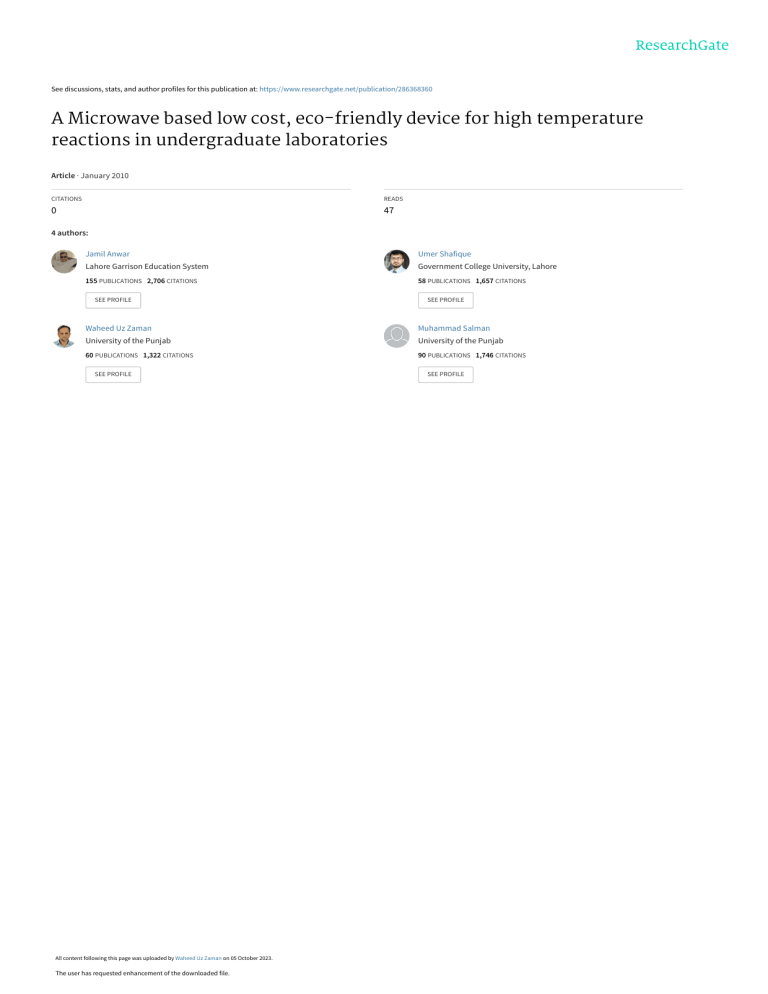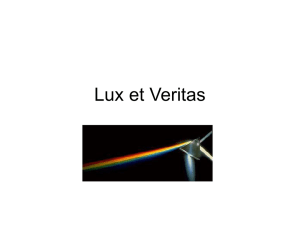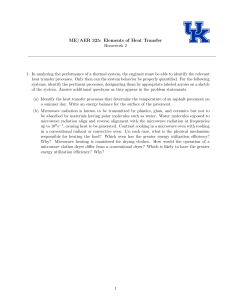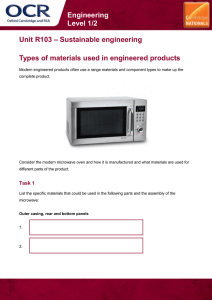
See discussions, stats, and author profiles for this publication at: https://www.researchgate.net/publication/286368360 A Microwave based low cost, eco-friendly device for high temperature reactions in undergraduate laboratories Article · January 2010 CITATIONS READS 0 47 4 authors: Jamil Anwar Umer Shafique Lahore Garrison Education System Government College University, Lahore 155 PUBLICATIONS 2,706 CITATIONS 58 PUBLICATIONS 1,657 CITATIONS SEE PROFILE SEE PROFILE Waheed Uz Zaman Muhammad Salman University of the Punjab University of the Punjab 60 PUBLICATIONS 1,322 CITATIONS 90 PUBLICATIONS 1,746 CITATIONS SEE PROFILE All content following this page was uploaded by Waheed Uz Zaman on 05 October 2023. The user has requested enhancement of the downloaded file. SEE PROFILE Õèìèÿ, ãîä. ÕIX, êí. 5 (2010) Chemistry, Vol. 19, Iss. 5 (2010) A MICROWAVE BASED LOW COST, ECO-FRIENDLY DEVICE FOR HIGH TEMPERATURE REACTIONS IN UNDERGRADUATE LABORATORIES Jamil ANWAR, Umer SHAFIQUE, Waheed uz ZAMAN, Muhammad SALMAN University of the Punjab, PAKISTAN . Abstract. Microwave heating is receiving a considerable attention by researchers all over the world. When comparing it to conventional heating, a different way of transferring energy from the source to the sample is the main advantage of utilizing microwave energy. Silicon carbide is a good microwave susceptor. When exposed to microwaves in a household oven, it heats up rapidly and becomes red-hot having a temperature above 1000oC. This fact has been utilized to design a model for carrying out elevated temperature reactions in a microwave oven to replace furnace and flame. This quick, safe, environment friendly and trouble-free experiment can be utilized to carry out high temperature reactions in undergraduate laboratories effortlessly. Keywords: fusion, microwave, silicon carbide, undergraduate laboratory Introduction In the last two decades, several articles have been published describing the possible use of microwave ovens in the undergraduate laboratories [1-6]. Advantageous decline in reaction time, increase in product yield due to minimum side reactions, high purity, easy availability and low price of microwave ovens are the major benefits of dielectric heating (through absorption of microwaves). In addition, elimination of car142 bonaceous fuels and minimal use of harmful solvents are other attractive aspects of microwave heating from ecological point of view. Being a safe, inexpensive and quick source of energy, the emerging technology of microwave heating found its way to undergraduate laboratories [6]. Most of the workers utilized domestic ovens (multimode), but it was found that such ovens have shortcomings like low reproducibility, uncontrolled heating and an inability to stir reactions resulting in splashing of the chemicals [7]. On the other hand, single-mode microwave ovens provide a safe and effective alternative; however, they are very pricey. New device for high temperature reactions in undergraduate laboratories Since most of the undergraduate laboratories, particularly in developing states, have inadequate funding, we have experimented with domestic microwave ovens those are financially feasible for laboratories of all levels. With the help of the proposed device, high temperatures (up to 2000oC) can be achieved in a multi-mode microwave oven operating at 2.45 GHz in few minutes. The device can be safely used for drying or igniting precipitate in gravimetric exercises, ashing the samples for analysis, depolymerization and fusion reactions. It consists of two silicon carbide slabs, one is plain and the other having a hole at the center, is placed at the top of former as shown in Fig. 1. The set of slabs is placed inside a domestic microwave oven on a thick ceramic tile. A china clay crucible containing reactants is placed in the hole of the upper slab, and oven is switched on for desired time. Ordinary furnaces heat up slowly under the given program and settings, while it is extremely dangerous to open furnace in a hot state. Conversely, no such type of safety parameter is required in case of a freshly mentioned device while the rate of heating is very high. Either exposing the device to microwaves for lesser time can control temperature or using one slab in place of two can do this job. The device is health and environment friendly as no gas or waste is generated those are usually produced in case of conventional heating. In addition, a hole can be made on the top of the oven that can direct noxious vapors or gases of the ongoing reaction to any route for proper ventilation. Fig. 1. Plain and holed slabs of silicon carbide and set of slabs (plain at bottom, then one with a hole and china clay crucible placed in hole at top (left to right) 143 Experiment 1: Degrading polyethylene terephthalate and recovering terephthalic acid Used PET bottles (colorless) were washed thoroughly, dried and cut into small chips. PET chips (2.0 g) and sodium hydroxide (8.0 g) were taken in a crucible and placed on set of slabs. Afterwards, the set was positioned in front of magnetron of a domestic microwave oven working at full power. In less than three minutes, slabs got red-hot and all the mass in the crucible started to fuse. Fusion was carried out for further three minutes and then, contents of the crucible after cooling at room temperature were poured in distilled water (100 mL). Concentrated hydrochloric acid was added drop wise to make the solution slightly acidic. White crystals of terephthalic acid (TPA) were settled out and were filtered and dried. Melting / sublimation point, solubility and IR analysis were employed to characterize recycled terephthalic acid, and it was found that the product was pure TPA. Total duration of the experiment was less than 2 hours and no sophisticated instrument or complex procedure was involved (FTIR is common in university laboratories these days). This indicates that experiment is easily practicable in undergraduate laboratories. Experiment 2: Measuring percentage ash in coal (Proximate analysis) Finely ground weighed sample of coal (3 g) was taken in a washed and dried china clay crucible that was placed on slabs. Afterwards, the whole set was put in a household oven and exposed to microwaves for 20 minutes. All the coal converted to ash that was weighed and used for further analysis and calculations. For comparison, percentage ash was also measured in a furnace according to specifications given in standard ASTM method (D-4326). There was no more than 2% error in the former method's results when comparing to standard method. On the other hand, microwave method only took 20 minutes while latter took 3 hours to complete. Experiment 3: Melting the sodium chloride Sodium chloride (1 g) was placed in the crucible that was placed on silicon carbide slabs. Later, the set was placed in the microwave oven and subjected to radiations for 10 minutes. All the mass present in the crucible became molten in the stated duration of time. On the other hand, furnace took more than 30 minutes to reach to a melting temperature. Safety precautions for undergraduate students (1) As the glass tray of the oven cannot bear high temperature, it should be removed and refractory brick should be used to place SiC slabs. (2) No need of ramping after the experiment, however, it is strongly advised to avoid touching red-hot slabs without proper safety. (3) Better to wear chemical splash goggles, heat resistant gloves and an apron. (4) Avoid boiling the reaction mixture or heating it to dryness. (5) 144 Use steel tongs to hold hot SiC slabs, however, it is strongly advised to wait for few minutes to lower down the temperature. (6) Do not inhale any vapors arising from the crucible while taking it out from oven. (7) It is strongly advised not to use oven for heating edibles after experimentation in the laboratory. REFERENCES 1. Parquet, E., Q. Lin. Microwave Assisted Wolff-Kishner Reduction Reaction. J. Chem. Educ. 74, 1225 (1997). 2. Dicks, A.P. Solvent-Free Reactivity in the Undergraduate Organic Laboratory. Green Chemistry Letters & Reviews 2, 89-100 (2009). 3. Musiol, R., B. Tyman-Szram, J. Polanski. Microwave-Assisted Heterocyclic Chemistry for Undergraduate Organic Laboratory. J. Chem. Educ. 83, 632-633 (2006). 4. Segstro, E., D.M. Goltz, T. Hall, A. Grant. Teaching Sample Preparation in the Undergraduate Laboratory. J. Chem. Educ. 77, 1486-1487 (2000). 5. Ng, L.-T., L.H.L. Chia. Practical Microwave Curing Studies for Undergraduates. Polymer International 48, 952-955 (1999). 6. Barnhardt, E.K., A.R. Katritzky, C. Cai, M.D. Collins, F.V. Scriven, S.K. Singh. Incorporation of Microwave Synthesis into the Undergraduate Organic Laboratory. J. Chem. Educ. 83, 634-636 (2006). 7. Mirafzal, G.A., J.M. Summer. Microwave Irradiation Reactions: Synthesis of Analgesic Drugs. J. Chem. Educ. 77, 356 (2000). Umer SHAFIQUE (corresponding author) E-Mail: umer0101@hotmail.com Jamil ANWAR Center for Undergraduate Studies, University of Punjab, Lahore - 54590 (PAKISTAN) Waheed uz ZAMAN, Muhammad SALMAN, Institute of Chemistry, University of Punjab, Lahore - 54590 (PAKISTAN) . 145 View publication stats




